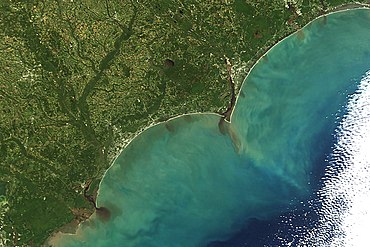
Colored dissolved organic matter (CDOM) is the optically measurable component of dissolved organic matter in water. Also known as chromophoric dissolved organic matter,[1] yellow substance, and gelbstoff, CDOM occurs naturally in aquatic environments and is a complex mixture of many hundreds to thousands of individual, unique organic matter molecules, which are primarily leached from decaying detritus and organic matter.[2] CDOM most strongly absorbs short wavelength light ranging from blue to ultraviolet, whereas pure water absorbs longer wavelength red light. Therefore, water with little or no CDOM, such as the open ocean, appears blue.[3] Waters containing high amounts of CDOM can range from brown, as in many rivers, to yellow and yellow-brown in coastal waters. In general, CDOM concentrations are much higher in fresh waters and estuaries than in the open ocean, though concentrations are highly variable, as is the estimated contribution of CDOM to the total dissolved organic matter pool.
- ^ Hoge, FE; Vodacek, A; Swift, RN; Yungel, JK; Blough, NV (October 1995). "Inherent optical properties of the ocean: retrieval of the absorption coefficient of chromophoric dissolved organic matter from airborne laser spectral fluorescence measurements". Applied Optics. 34 (30): 7032–8. Bibcode:1995ApOpt..34.7032H. doi:10.1364/ao.34.007032. PMID 21060564.,
- ^ Coble, Paula (2007). "Marine Optical Biogeochemistry: The Chemistry of Ocean Color". Chemical Reviews. 107 (2): 402–418. doi:10.1021/cr050350+. PMID 17256912.
- ^ "Ocean Color". NASA Science. Retrieved 26 November 2018.